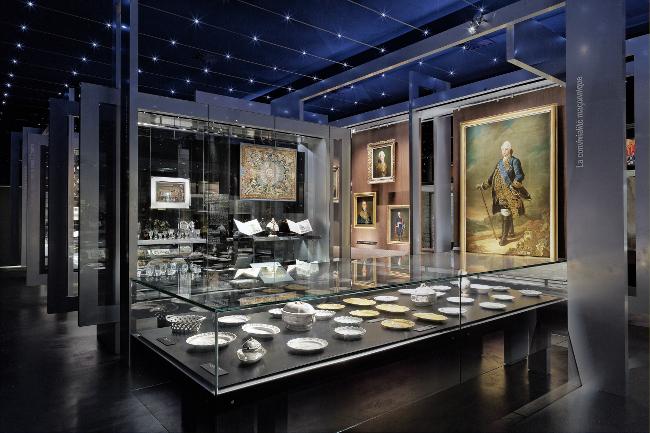Created in 1889, the Parisian museum, located at the headquarters of the Grand Orient de France, continues to explain Masonic history and rites. The opportunity, too, to "fight against the somewhat silly image of a completely secret Freemasonry".
Of course, there is no need to go through an initiation ceremony to visit the Freemasonry Museum: the place, which receives 20,000 visitors a year on rue Cadet (9th arrondissement), is open to the public. Located just after the reception in the Hôtel du Grand Orient de France, the display cases highlight around 700 pieces (out of the 7,000 counted in the inventory).
Paintings, textiles, earthenware, jewellery, documents, various objects… There is notably the Masonic sword of La Fayette, the Masonic apron of Hugo Pratt or even an apron attributed to Voltaire. The oldest piece: Anderson's Constitutions, published in London in 1723. Either "the founding text of modern Freemasonry", explains Pierre Mollier, the museum's curator. Squares, compasses, stars… Many symbols associated with the institution are displayed in the window.
The permanent exhibition tries, over 400 m2, to "explain what Freemasonry is and its contribution", underlines Pierre Mollier: "The Masonic tradition has been rooted for three centuries in the history of France. Freemasonry as an auxiliary of the Enlightenment, then as a vector for the dissemination of the democratic, liberal, republican camp. But beyond politics, there is also an imprint in the field of philosophy and the arts, with for example example Goethe, Mozart or the sculptor Jean-Antoine Houdon."
200 m2 of the museum are also dedicated to temporary exhibitions, often more specialized (on Masonic rites in particular) but sometimes aimed at the general public ("Templars and Freemasons, from legend to history" for example).
Looted during the Second World War, the museum is still trying to rebuild its collections

The creation of the museum dates back to 1889. "Originally, it was rather a cabinet of curiosities, recounts Pierre Mollier. A little before the First World War, it was open to the public from time to time, then the museum continued to developed during the interwar period. But during the Second World War, Freemasonry was banned and Masons were persecuted and harassed. The Vichy police even had a special service to fight against secret societies. There was much destruction, and the collection is scattered."
In the inventory, the historical collection - which concerns everything that does not come from the repurchases after the looting - today only has 50 pieces "at most". "Our goal is to reconstruct our magnificent collections looted during the war, from auction to auction, says the curator. When I look at the pre-war inventories, it was wonderful. Sometimes, we buy even things that were stolen from us, but hey, decades later… And people are in good faith."
After the "burglary of 1940", "the Grand Orient will have a lot of trouble recovering from these dark years", continues Pierre Mollier. Remained closed for twenty years, the museum returned in 1973 by opening to the public, before a major renovation from 2008 to 2010.
"People come to visit a museum on Freemasonry but also to meet Masons"
Beyond their historical value, the pieces exhibited today are also a way to go against certain prejudices, according to the curator: "This is not the primary objective of the museum, which is above all scientific and cultural. But in the background, the idea is indeed to fight against the somewhat silly image of a completely secret Freemasonry. When there are groups of visitors, we often show the building and Masonic temples."
"Certainly, it is an initiatory organization, so there is part of the activity that is done under cover, he continues. But the Grand Orient is an association under the law of 1901. Our statutes are deposited at the prefecture. And Everyone has a Freemason cousin, friend or colleague There have been lodges for centuries in every town and city Masons are middle-class people: it could be the history teacher - geo of your children, your pharmacist, your physiotherapist or your account manager at the bank."
Pierre Mollier also explains that visitors often come to the museum "to meet Freemasons" with "always a form of curiosity". "In the Grand Orient, there are not only masons, it's about 50-50, he also notes. In the museum team, we are all masons, but that's new. It is still important to be a builder for those who are at the reception, because visitors ask them a lot of questions.
There are nearly 200,000 members of Freemasonry in France, including about 50,000 in the Grand Orient (the oldest current) and 30,000 in the Grand Lodge (resulting from a split), indicates the curator. Note that until spring, a temporary exhibition focuses on Masonic rites influenced since the beginning of the 19th century by the Egyptian expedition and esotericism.
DIRECT. Assassination of Razia Askari in Besançon: "No guilt, no remorse, lack of empathy", the profile of Rashid Askari, accused of the assassination of his wife, dissected
[Video] The Amazing Spider-Man 2: the ultimate trailer
Nantes. He had assaulted a tram driver: sentenced to 6 months, he avoids prison
Samsung AU9000 Test | TechRadar